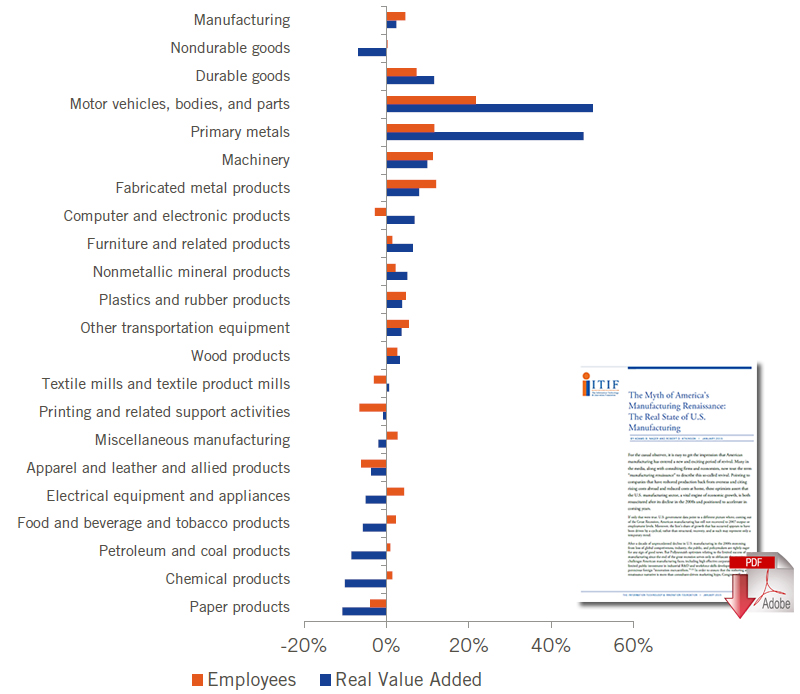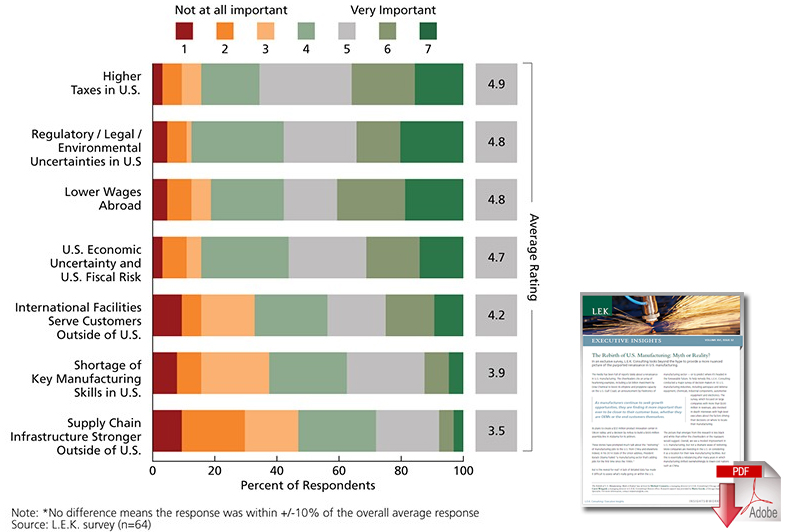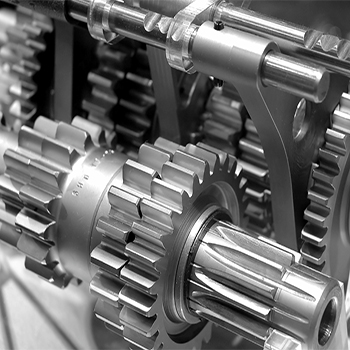The Myth of America’s Manufacturing Renaissance

A new report by the ITIF, assesses the true status of the American manufacturing economy and argues pundits have overestimated the impact of isolated incidents of reshored production and misread or ignored the data.
For the casual observer, it is easy to get the impression that American manufacturing has entered a new and exciting period of revival.
Many in the media, along with consulting firms, think tanks, and economists, now proclaim the emergence of a U.S. “manufacturing renaissance,” marked by the “reshoring” of production and the growing competitiveness challenges of many foreign nations vis-à-vis the United States. If only this were true.
The Myth of America’s Manufacturing Renaissance: The Real State of U.S. Manufacturing, a new report by the Information Technology and Innovation Foundation (ITIF), assesses the true status of the American manufacturing economy and argues pundits have overestimated the impact of isolated incidents of reshored production and misread or ignored the data.
If there were a true renaissance, we’d expect to see growth in inflation-adjusted manufacturing value added. But in fact 2013 manufacturing value added is 3.2 percent below 2007 levels, with non-durable goods value-added (which includes chemicals and oil and gas) down almost 12 percent. U.S. manufacturers employ over a million fewer workers and there are 15,000 fewer manufacturing establishments since the beginning of the Great Recession. Moreover, America ran a $458 billion trade deficit in manufacturing goods in 2013. Hardly evidence of a renaissance.
Manufacturing Growth from 2010 to 2013

And most of the recovery that has occurred has been cyclical in nature. In fact, 122 percent of manufacturing output growth between 2010 and 2013 was in the auto sector, whose growth is due almost solely to a rebound in U.S. consumer demand, rather than reshoring of automobile production.
“Most of the claims for a structural rebirth of U.S. manufacturing are unfortunately based on myths and anecdotes,” states Robert Atkinson, President of ITIF and co-author of the report. “Instead, any assessment of U.S. manufacturing should be based on rigorous analysis and review of the official data.”
The report first reviews a wide range of government data sets to present a clearer picture of the U.S. manufacturing environment. It then rebuts a number of myths about manufacturing renewal. These include:
Myth: U.S manufacturing has recovered from the Great Recession.
Fact: Despite 3 years of steady growth, manufacturing employment and output numbers are below where they were in 2007.
Myth: The United States only lost jobs and production in low-wage, low-skill industries.
Fact: The United States has struggled in advanced technology goods, and in 2013 ran an $81 billion dollar trade deficit. Additionally, United States production in machinery has fallen 3 percent and electrical equipment, appliances, and components output has fallen by 13.8 percent since 2007.
Myth: China’s rising labor costs are leveling the playing field.
Fact: Chinese wages, while rising, are estimated to be just 12 percent of average U.S. wages in 2015. Moreover, growth in wages is in some part offset by rapid Chinese labor productivity growth.
Myth: The shale gas boom gives U.S. manufacturing a substantial advantage.
Fact: Reduced costs for shale energy have only had an impact on energy-intensive industries, and then only a minor one. For 90 percent of the manufacturing sector, energy costs are lower than 5 percent of shipment value. Moreover, real value added in the petroleum refining and chemical sector actually declined by over 9 percent between 2010 and 2013.
“Pollyannaish optimism relating to the limited success of manufacturing since the end of the great recession serves only to obfuscate the ongoing challenges American manufacturing faces, including high effective corporate tax rates, limited public investment in industrial R&D, and pernicious foreign ‘innovation mercantilism’,” notes Adams Nager, Economic Research Assistant with ITIF and co-author of the report. “In order to ensure that the renaissance narrative is more than marketing hype, Congress will need to act boldly to address the issues American manufacturers face.”
U.S. Manufacturing Comeback: Nice Story…If Only It Were True
Is that nice story about the return of “Made in America” simply made-up?
The U.S. has added some 520,000 manufacturing jobs over the past three years. That’s led many analysts to declare an American manufacturing renaissance. But according to a new report from the Information Technology and Innovation Foundation, that’s not really the case.
The report, titled “The Myth of America’s Manufacturing Renaissance: The Real State of U.S. Manufacturing” argues that while the U.S. economy added those more than half-million jobs, that’s compared to the 2.5 million lost in the Great Recession. The Information Technology and Innovation Foundation is a non-partisan, non-profit think tank based in Washington, D.C.
“I wouldn’t say it’s a myth,” says Yahoo Finance Senior Columnist Michael Santoli, “[But] it’s probably been exaggerated at least in terms of jobs.”
The report contradicts a popular narrative among analysts and the media that U.S. manufacturing has seen a broad-based recovery and that the boom in U.S. oil and gas production continues to fuel it. Boston Consulting Group has been leading the drumbeat for a few years. But the authors of the report say, “The lion’s share of growth that has occurred appears to have been driven by a cyclical, rather than structural, recovery, and as such may represent only a temporary trend.”
The U.S. is no longer losing jobs in the sector, but as Yahoo Finance editor-in-chief Aaron Task and Santoli discuss in the video below, the economy will likely never regain all the jobs since the 1980s.
However, there is evidence of growing investment in the sector because of low oil and natural gas costs. Dow Chemical is building a new plant in Texas which will open in 2017. Airbus will open its first production facility in North America later this year. Companies like Siemens have rolled out high-tech apprenticeship programs for manufacturing plants in the U.S. to train young Americans for new jobs in the industry.
“It‘s too anecdotal,” says Santoli, and focused on the idea that it is all “going to come back.” He says the industry is changing. “It’s not really about coming back. It might be about new industries building things here.” He points to the auto industry and in particular Tesla building cars in the U.S.
It’s not just about manufacturing changing, it’s about the U.S. labor force on the whole changing. The collective fascination with U.S. manufacturing is “nostalgia for good middle class jobs you didn’t need a college education for,” says Santoli. “Is manufacturing better than a UPS driver job or a solar panel installer jobs?”
“We’re not going to start manufacturing t-shirts in North Carolina again. We’re not going to start making small electronics in Texas again,” he says. “That stuff is gone. It has to be something new.”
Source: Yahoo Finance
The Rebirth of U.S. Manufacturing: Myth or Reality?
In this Executive Insights, L.E.K. Managing Directors Michael Connerty and Carol Wingard discuss five critical themes that are playing out across several manufacturing industries:
- Strong End-Market Demand
- Managing Supply Chain Risk
- Narrowing Differences in Energy and Labor Costs
- Innovation, Differentiation and Speed to Market
- Business Environment and Regional Attractiveness
One thing is clear - optimism about the future of U.S. manufacturing is relatively buoyant, as 68% of the executives surveyed agreed that U.S. manufacturing will experience accelerated growth in the next five years. L.E.K. discusses the trends in U.S. manufacturing and whether a renaissance is really on the rise.
Factors Hindering U.S. Manufacturing from Achieving Growth

Source: L.E.K. Consulting
Related: US Manufacturing Only 5 Percent More Costly Than China, Strengthens Case for Reshoring

Article Topics
ITIF News & Resources
Stop Talking About US Manufacturing Jobs Coming Back, Because They’re Not! U.S. Manufacturing Still At a Two-Year Low Is U.S. Manufacturing In a Technical Recession? Why Americans Are So Nostalgic About The Manufacturing Industry The Myth of America’s Manufacturing Renaissance: The Real State of U.S. Manufacturing The Myth of America’s Manufacturing Renaissance The Acquisition and Commercialization of Invention in American Manufacturing: Incidence and Impact More ITIFLatest in Supply Chain
TIm Cook Says Apple Plans to Increase Investments in Vietnam Amazon Logistics’ Growth Shakes Up Shipping Industry in 2023 Spotlight Startup: Cart.com is Reimagining Logistics Walmart and Swisslog Expand Partnership with New Texas Facility Nissan Channels Tesla With Its Latest Manufacturing Process Taking Stock of Today’s Robotics Market and What the Future Holds U.S. Manufacturing Gains Momentum After Another Strong Month More Supply Chain













